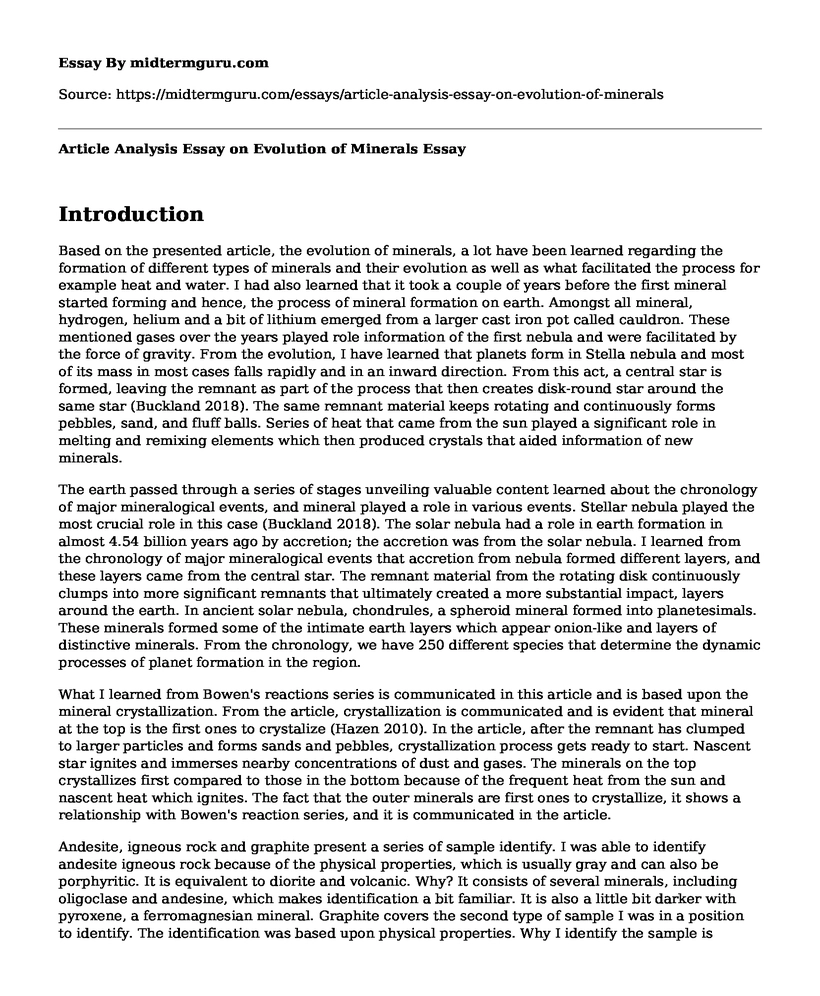Introduction
Based on the presented article, the evolution of minerals, a lot have been learned regarding the formation of different types of minerals and their evolution as well as what facilitated the process for example heat and water. I had also learned that it took a couple of years before the first mineral started forming and hence, the process of mineral formation on earth. Amongst all mineral, hydrogen, helium and a bit of lithium emerged from a larger cast iron pot called cauldron. These mentioned gases over the years played role information of the first nebula and were facilitated by the force of gravity. From the evolution, I have learned that planets form in Stella nebula and most of its mass in most cases falls rapidly and in an inward direction. From this act, a central star is formed, leaving the remnant as part of the process that then creates disk-round star around the same star (Buckland 2018). The same remnant material keeps rotating and continuously forms pebbles, sand, and fluff balls. Series of heat that came from the sun played a significant role in melting and remixing elements which then produced crystals that aided information of new minerals.
The earth passed through a series of stages unveiling valuable content learned about the chronology of major mineralogical events, and mineral played a role in various events. Stellar nebula played the most crucial role in this case (Buckland 2018). The solar nebula had a role in earth formation in almost 4.54 billion years ago by accretion; the accretion was from the solar nebula. I learned from the chronology of major mineralogical events that accretion from nebula formed different layers, and these layers came from the central star. The remnant material from the rotating disk continuously clumps into more significant remnants that ultimately created a more substantial impact, layers around the earth. In ancient solar nebula, chondrules, a spheroid mineral formed into planetesimals. These minerals formed some of the intimate earth layers which appear onion-like and layers of distinctive minerals. From the chronology, we have 250 different species that determine the dynamic processes of planet formation in the region.
What I learned from Bowen's reactions series is communicated in this article and is based upon the mineral crystallization. From the article, crystallization is communicated and is evident that mineral at the top is the first ones to crystalize (Hazen 2010). In the article, after the remnant has clumped to larger particles and forms sands and pebbles, crystallization process gets ready to start. Nascent star ignites and immerses nearby concentrations of dust and gases. The minerals on the top crystallizes first compared to those in the bottom because of the frequent heat from the sun and nascent heat which ignites. The fact that the outer minerals are first ones to crystallize, it shows a relationship with Bowen's reaction series, and it is communicated in the article.
Andesite, igneous rock and graphite present a series of sample identify. I was able to identify andesite igneous rock because of the physical properties, which is usually gray and can also be porphyritic. It is equivalent to diorite and volcanic. Why? It consists of several minerals, including oligoclase and andesine, which makes identification a bit familiar. It is also a little bit darker with pyroxene, a ferromagnesian mineral. Graphite covers the second type of sample I was in a position to identify. The identification was based upon physical properties. Why I identify the sample is because most of them are found near the earth's surface. I identify because of it easy; it has a steel gray color and cleavage is perfect in one direction.
References
Buckland, W. (2018). Geology & Mineralogy, Considered with Reference to Natural Theology, Volume II, 1836. Routledge. https://www.taylorfrancis.com/books/9780203489369
Hazen, R. M. (2010). Evolution of minerals. Scientific American, 302(3), 58-65. https://www.researchgate.net/publication/41576896_Evolution_of_Minerals
Cite this page
Article Analysis Essay on Evolution of Minerals. (2022, Sep 12). Retrieved from https://midtermguru.com/essays/article-analysis-essay-on-evolution-of-minerals
If you are the original author of this essay and no longer wish to have it published on the midtermguru.com website, please click below to request its removal:
- Types of Biological Agents
- Discussion on Environmental Services on Areas That Inhibit the Growth of Bacteria - Paper Example
- Research Paper on Microbiology
- Critical Essay on From Dust to Life: the Origin and Evolution of Our Solar System
- CTE: Brain Injuries, Thinking & Memory Problems, and Behavioral Changes - Research Paper
- Brain Injury: Altering My Mental State and Cognitive Abilities - Essay Sample
- A Woman With A 24-Hours Memory - Essay Sample







